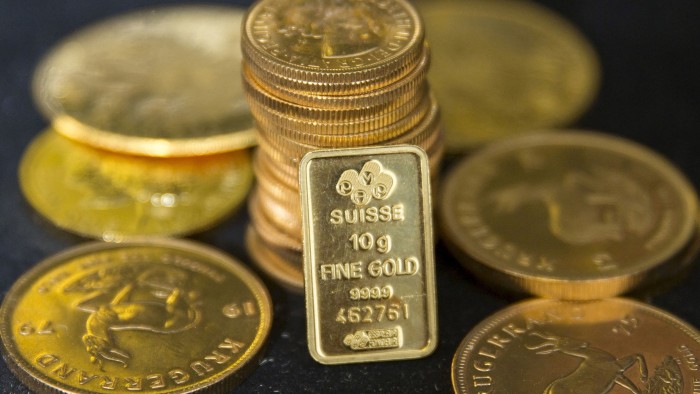This article is an on-site version of our Unhedged newsletter. Premium subscribers can sign up here to get the newsletter delivered every weekday. Standard subscribers can upgrade to Premium here, or explore all FT newsletters
Good morning. Jay Powell was successfully boring in his testimony before the Senate yesterday. The Fed is in no hurry to cut rates, it will focus on the data, it will remain independent. Short-term rates barely twitched. Were only the rest of the world as predictable. Email us: [email protected] and [email protected].
What gold is telling us now?
Gold staged an amazing rally between February and October 2024; the price rose by more than a third. This followed a period of more than three years when the crisis asset extraordinaire went sideways, despite a roller-coaster ride in interest rates and risk assets. Why gold rallied just when it finally did remains slightly mysterious but seems to have to do with a structural shift in global demand, particularly from central banks.
Unhedged admits to having felt a bit of relief — for intellectual rather than financial reasons — when gold started trading sideways again in October. A stable gold price meant one less confusing thing to think about in a puzzling market thrown into disorder by the US presidential election. That hiatus is over, however. In 2025 gold has surged another 10 per cent, crashing though the all-time high it set three months ago.

What does this signal about global markets?
The trivial explanation for why gold (or any asset) goes up is that more people want to buy it. And there is evidence of strong demand for gold recently. The Chinese central bank increased its gold holdings for the third straight month in January. And, according to the World Gold Council, inflows into bullion-backed ETFs were $3bn last month, a strong month after notable weakness in November and December. European gold funds took in $3.4bn, their highest inflow in almost three years. China has good reason to diversify its reserves away from the dollar, and Europe is waiting for the US tariff hammer to fall. Higher gold demand makes sense in both places.
Just as important, there is totally standard macroeconomic logic at work since the gold price really started to move in mid-January. Real interest rates (as proxied by inflation-adjusted 10-year Treasury yields) have fallen by 25 basis points — so the opportunity cost for owning gold has been falling. The dollar has weakened, too, providing further price support, given the gold is priced in dollars. To the extent that these factors explain what is going on, the mystery isn’t gold. It is why the “Trump trade”, which calls for a stronger dollar and higher long-term rates, has gone into reverse recently.

What explains the reversal in the dollar and in real rates, which had been steadily rising since Trump’s re-election began to look likely back in September? Tactically, this is probably the central question in markets right now. There are at least three possible explanations. It could be that markets see US economic growth slowing, for reasons involving the business cycle, monetary policy or Trump’s fiscal/economic policies. Alternatively, it could be that the dollar and real rates rose in anticipation of swinging US tariffs (which would naturally support both), but the market now thinks the Trump administration was bluffing about that. Finally, the reason could be technical. Maybe the Trump trades got overcrowded and they are taking a breather before surging back to life. Perhaps a combination of all three explanations is at work. We probably won’t know the real mix until US tariff policy becomes clearer over the next few months.
Concentration in emerging market indices
When global equity markets are dominated by the US, and the US equity markets are dominated by big technology stocks, the best argument for an allocation to emerging market stocks is diversification. Unfortunately, as the FT’s EM correspondent Joseph Cotterill pointed out to us, EM indices have become very top-heavy, too.
Tech — and one tech company in particular, TSMC — has powered growth in the more developed “emerging” markets such as China, Taiwan and South Korea. Here is the weighting of the top 10 equities MSCI emerging markets index in 2019 and 2025, with tech companies in red:

TSMC is now more than 10 per cent of the index, and new tech names are contributing significant weights. In MSCI’s emerging markets ex-China index, TSMC is 15 per cent of the index, and tech companies make up more than 20 per cent. This is a trend in country-specific indices, too; according to a report from Morningstar, indices for Brazil, Taiwan, Korea and India have become more concentrated around their domestic mega caps, often in tech.
There is also the issue of country concentration. Here is a chart from Morningstar, showing how India and Taiwan have taken up more and more of its EM index since 2019:

Tech concentration makes EM indices a less effective diversifier in a global portfolio. TSMC, Tencent and Samsung rely heavily on the same AI narrative that drives the Magnificent 7. And stockpicking is difficult in concentrated markets when the biggest stocks have momentum. The choices are to hug the index or take on significant career risk.
All that concentration comes with some upside, though, in the form of growth and valuation. While EM companies tend to have smaller US exposures than their developed market peers, many of the big EM tech companies — particularly TSMC and Samsung — do get a large share of their revenues from America. A few weeks back, we discussed whether owning EU or UK stocks might provide cheap exposure to US growth, using a price/earnings-growth analysis — the “peg” ratio. A similar exercise makes the EM indices look like an inexpensive way to add growth exposure:

Emerging market equities are volatile. They require careful handing. But at a moment when growth is usually unavailable at a reasonable price, EM remains interesting, despite the concentration problem.
(Reiter)
One good read
Immigration and lactation.
FT Unhedged podcast

Can’t get enough of Unhedged? Listen to our new podcast, for a 15-minute dive into the latest markets news and financial headlines, twice a week. Catch up on past editions of the newsletter here.
Recommended newsletters for you
Due Diligence — Top stories from the world of corporate finance. Sign up here
Free Lunch — Your guide to the global economic policy debate. Sign up here
https://www.ft.com/content/fd2ea95b-9533-4eaf-8a02-633aff5a30d8


